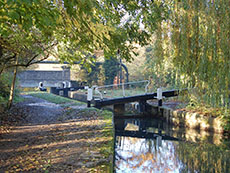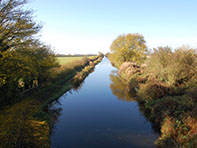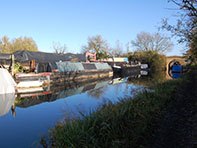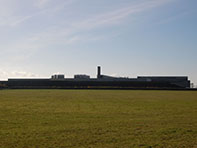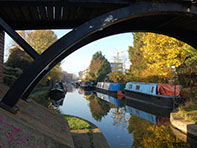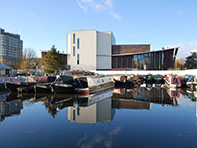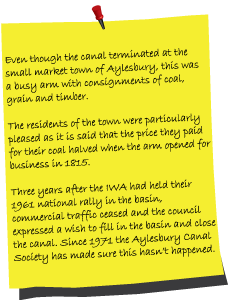
The Aylesbury Arm is just over 6 miles long and descends 95ft from Marsworth Junction to Aylesbury Basin. After overcoming the opposition of the Grand Junction canal who thought that it would be a drain on their precious water, the arm opened in 1814 with narrow locks as a conservation measure. Goods carried on the canal were agricultural in nature from Aylesbury passing incoming industrial and building materials. However, plans for a Western Junction canal to continue to Abingdon on the Thames never materialized due to the recalcitrance of landowners along the route.
At Marsworth Junction you'll find the sparkling new Marsworth Wharf, an environmentally friendly housing development that replaced Marsworth Yard, a derelict post-war British Waterways depot. Immediately you pass the staircase Locks 1 and 2 which are surprisingly deep and after bridge 1 a rural scene emerges with stables and pasture. This is flat agricultural country and more locks follow at a brisk pace, among them Black Jack's Lock 4 with its attractive lockkeeper's cottage, and Jefferies Lock 8 which is swiftly followed by new properties in the same style as Marsworth Wharf.
Wilstone Lock 9 is the last of the Marsworth flight. Here Gudgeon Brook introduces water from Wilstone reservoir and nearby Gubblecote is where a chimney sweep by the name of Thomas Colley was hanged for his leading role in drowning a suspected local witch, Ruth Osborne, by the outlawed ducking method in 1751.
The canal continues arrow straight under bridge 6 and high hedges obscure the landscape to Puttenham Top Lock 10. The towpath can be very muddy due to cyclists but quiet until you reach Lock 11. Here you pass Bates Boatyard. It's an interesting place that displays the wooden narrowboats that they specialize in repairing and building.
The canal subsequently opens out and you catch sight of a huge building on the left. This is the £150m, 70 acre milk processing plant at Aston Clinton, the world's first billion litre mega-dairy. It stands in a slightly elevated position like a cathedral to dairy products overlooking Aylesbury Vale.
Red House Lock 13 is particularly pretty with a picnic table and following bridge 9 there's a few moored boats next to the arm's only winding hole at a former coal wharf. The canal becomes rather featureless and in fact hidden behind tall reeds in the summer. It's been a very pleasant rural walk, give or take the odd mega-dairy but, in winter, a few ducks and the Tring Angling Club representative chasing half a dozen pike fishermen for money, don't add a lot of interest to the long straight sections.
From Bridge 13 the number of people you meet starts to increase and, approaching Aylesbury, the towpath partly improves and at Circus Field Basin you'll find the Aylesbury Canal Society who did so much in the 1970s to save the arm from closure.
Aylesbury really starts to kick in at the concrete bridge 16A carrying the ring road, playing fields are adjacent and the bridge is decorated with a rather nice mural. After crossing Bear Brook at Lock 15 the tow path is very good and there are apartments on the left and factories on the far side. You pass visitor moorings and the final Lock 16 (Hills & Partridges named after two local flour millers) is rather tranquil, overseen by a huge weeping willow. Modern apartments take over until the last road bridge (18), then there are rows of attractive cottages as the totally redeveloped Aylesbury Basin comes into view as you pass the attractive bridge 19.
Here you'll find clean quiet moorings overlooked by Buckinghamshire New University, a Travelodge and the Waterside Theatre that was opened in 2010 by Cilla Black.
View Aylesbury Arm in a larger map
